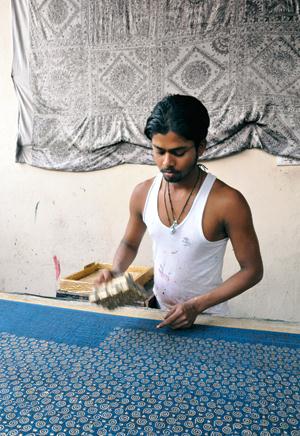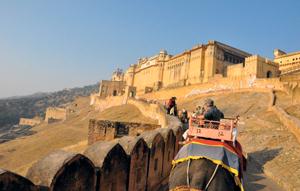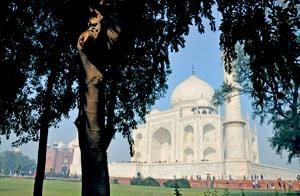
Traditional ink-block printing on pashmina and silk is a common sight in Jaipur's fabric district. Some of the ink blocks are hundreds of years old. Credit: David Walberg

A quiet moment on the steps of the Jama Masjid mosque, overlooking Old Delhi's Meena Bazaar. Credit: David Walberg

An elephant ride is the best way to trek up the hill to the Amber Fort, located just outside of Jaipur. Credit: David Walberg
The stark contrasts stand out most in my mind: poverty and extravagance, ancient and modern, pristine and positively grimy, delightfully aromatic and downright smelly — my trip to India was defined by disparities.
My six-day, breakneck tour of northern India — hosted by Out Journeys, which specializes in gay and lesbian travel to the subcontinent — began in the capital. I wasn’t sure what to expect as the bus inched its way through traffic gridlock into the city centre, but we were soon surrounded by Delhi’s eclectic mix of architecture, both old and new. The numerous Hindu temples, Mogul forts, Muslim mosques and British Raj–era palaces were a refreshing change from the columned and buttressed Occidental style I am so accustomed to seeing.
The jewel in Delhi’s architectural crown has got to be the Rashtrapati Bhavan, the world’s largest presidential palace. Flanked by Parliament House and the Secretariat, the complex is enormous. Just up the street from this palace on steroids is an area known as the Bungalow Zone: street after street of mini-palaces and magnificent gardens dating back to the British Raj, now home to India’s political elite. Delhi residents obviously have a completely different definition of the word bungalow — these are no modest single-level homes!
Just north of New Delhi is the walled city of Old Delhi. Although much of the wall has disappeared, many of the magnificent entry gates remain. The old section of Delhi is a tangle of streets littered with bazaars, chowks (open-air markets) and an ever-present throng of people and livestock. My first time weaving through traffic — some of it oncoming! — in a rickshaw was more than a little hair-raising. But once I relaxed my white-knuckled grip on the armrest, the ride was actually quite enjoyable; rickshaws are really one of the best ways to explore this part of Delhi.
Sightseeing in India is always accompanied by street vendors. I was constantly surrounded by young men trying to sell me maps, postcards and a plethora of shiny objects. I was surprised to find that this interaction also often involved my favourite pastime — flirting. On more than one occasion a vendor hooked his arm in mine or held my hand as he showed me his bejewelled trinkets. And there was always a wink and a smile in the sales pitch.
I soon noticed that this sort of interaction was occurring all around me. Indian men are not afraid to touch each other, hold hands or walk arm in arm. Shows of affection are clearly not the threats to masculinity they are in much of the West.
After leaving Delhi, we headed to Varanasi, one of the oldest continuously inhabited cities in the world. Situated on the banks of the River Ganges, it is known as the City of Temples; to go there is like visiting another era.
The old section doesn’t appear to have changed since it was first built. It is still a network of unbelievably narrow streets littered with temples, shrines, shops and homes. The banks of the Ganges are dotted with ghats — steps — leading into the holy river, which is used for religious ceremonies, ritual bathing and — a scene that gave my emotions a jolt — open-air cremations. With its red-, orange- and yellow-painted buildings, brightly attired residents, and bolts of multicoloured cloth laid out to dry on the river banks, Varanasi is a strikingly colourful city.
In addition to its religious significance, Varanasi is probably best known for its fine silk weaving. Browsing the bazaars and chowks between the old and new parts of the city, I found some truly amazing silks and exquisite saris. And just as in Delhi, the streets of Varanasi are pulsating with cars, people, rickshaws and livestock. So much so that walking in a straight line is out of the question.
Like those of Delhi, the men of Varanasi blur the lines of sensuality and flirtation. Heading down the city’s main street, I caught the gaze of a man on a moped who gave me a big toothy smile and blew me a kiss.
My first thought was that blowing a kiss has a completely different meaning in India — like, “Watch out for that pile of monkey poo right in front of you” — but our Indian guide assured me that it is a common way to compliment someone. Apparently many Indian men have no hang-ups about appreciating other men’s appearances or even suggesting they’re attractive.
A day of delightful flirtation later, we clambered on and off a series of planes and buses to travel to Agra.
Agra is best known for its contribution to the Seven Wonders of the World, the Taj Mahal. Having seen many photos of this mausoleum dedicated to love, I wasn’t expecting to be as moved as I was seeing it in person. This architectural masterpiece is more sculpture than building, with its pristine white marble and intricate stone inlays, set in a sprawling Persian garden. Nestled among trees, flowers and reflecting pools, the gleaming building imparts a complete sense of calm.
I was told that the best time to visit the Taj Mahal is at sunrise or by moonlight, for an even greater sense of calm and beauty. I’m not really a sentimental person, but my immediate thought was that I have to bring my partner to India, if only to show him this.
From Agra, we rode by bus through Fatehpur Sikri and Bharatpur. I had dreaded the prospect of yet another bus ride, but this one, through the countryside, was memorable. This part of rural India, with its small villages, farmland, rolling hills and never-ending fields of yellow mustard and red chillies, is strikingly beautiful. But seeing the small villages, and getting a sense of what life is like for much of the population, was an eye-opening experience. My North American concept of basic needs, such as indoor plumbing and electricity, or essential luxuries, such as home appliances and computers, are inconceivable in this part of the world.
The northern tour ended in Jaipur, India’s “Pink City.” Everything was painted pink in 1876 to welcome Prince Albert, and the city maintains its hold on the title by receiving a regular terra cotta wash. Like many other cities in India, Jaipur is a shopper’s paradise. The bazaars and markets are full of all the usual tourist trinkets and shiny objects, but locals and foreigners alike make the trek to Jaipur to purchase hand-knotted silk rugs and custom-designed jewellery.
Once the seat of Indian royalty, Jaipur boasts its share of monuments, palaces and temples. Probably the most magnificent of these is the Amber Fort, a sprawling 16th-century complex built on the side of a hill. Essentially, it is miles of courtyards, gardens and mini-palaces. You can either hike up the hill to the fort or hitch a ride on the back of an elephant. However you choose to reach the summit, be sure to visit the Sheesh Mahal, a suite of rooms decorated with thousands of miniature mirrored tiles that make the rooms sparkle as if studded with diamonds.
Every palace, monument and fort in India begs to be photographed. Still, I was a bit confused and a little surprised — though happy to oblige — when a young Indian man asked if I would pose with him in front of a beautiful minaret and setting sun. While his friend aimed the camera, he stood next to me, smiled, then hooked his arm around my waist and leaned into my shoulder. No difficulty smiling into the camera for that shot! In Jaipur, just as I had discovered elsewhere in Northern India, the architecture is magnificent, the scenery is incredible and the men are always smiling and not afraid to be affectionate.
Planning your trip to India
A bit of prep work is required for your trip to India. To start, all foreign nationals entering the country need travel visas. Getting them can take a while, so plan ahead. Check with the nearest Indian consulate for forms and procedures.
You will need to consult with your doctor at least one month before you travel to ensure your vaccinations are up to date.
Depending on your departure city, flights to India can be long and sometimes complicated, requiring connections or layovers. For some people, sitting on a plane for many hours is not an option, so a connecting flight with a one- or two-day layover might be a good idea. For those who just want to get there in one shot, the bigger carriers offer frequent direct flights from major airports. If you choose to fly American Airlines, you might want to consider splurging on one of its sleeper pods. Getting eight hours of comfortable sleep while in transit really does make a difference.
India has a lot to offer, and for most of us it won’t be a yearly vacation, so you will want to see and do as much as you can while you’re there. Arranging your trip through a tour company can help with that. Out Journeys specializes in gay and lesbian travel to India, with catered trips and fixed travel packages. Although not focused specifically on the gay and lesbian market, Go India Journeys will ensure your time in India is memorable.

 Why you can trust Xtra
Why you can trust Xtra